Agios Dimitrios Thessaloniki – a beautiful Byzantine basilica – is a UNESCO World Heritage site and one of the city’s principal landmarks among the many glorious Byzantine churches in Thessaloniki.
But above all, this is the spiritual heart of the city. It’s the church of the patron saint of Thessaloniki – Agios Dimitrios (Saint Demetrios) – and its history is deeply intertwined with many key events in the life of city. The Church of Agios Dimitrios is central to an itinerary of the city, either secular or sacred.
This is also the geographic heart of the city, overlooking the Roman Forum and the bay of Thermaikos.
Agios Dimitrios – Thessaloniki’s Patron Saint

Demetrios of Thessaloniki was born to a prominent family in 270 AD, and he became a high ranking officer in the Roman military. He was a Christian, and was ultimately denounced by his fellow officers. Galerius Maximus (you’ll know him because of Thessaloniki’s Kamara– his triumphal arch – and the Rotonda), a persecutor of Christians, imprisoned Demetrios in a Roman Bath house.
Even from prison, Saint Demetrios continued to serve Christ and to inspire – most notably, he inspired a young Christian named Nestoras. Nestor was to fight the great pagan gladiator Lyaios (Leo) – a giant of a man – in one-to-one combat. Nestor, though slight in stature, had faith on his side. With the blessing of Demetrios, he achieved a miraculous victory – much as David slayed Goliath. Galerius Maximus was enraged that his favorite gladiator was slain. He had Nestor beheaded, and Demetrios executed by spear. According to tradition, the bath house was the site of his martyrdom, in 306 AD.
Agios Dimitrios – a military saint – is usually depicted in his military uniform. In the following centuries, Saint Demetrios was credited with protecting the city through many sieges. Holy Myrrh was said to flow miraculously from his relics, giving him the name “Myrovlitis.”
During the Ottoman era, Saint Demetrios continued to be worshiped by both Christians and Muslims. For the Muslims, as Kasimiye – more on that below.
Agios Dimitrios and the Liberation of Thessaloniki

If you’re staying near the center of town in Thessaloniki on the night of October 25th, you make wake just before sunrise on the 26th of October to the victorious sound of a marching band. This is the military band, commemorating a momentous event in the history of Thessaloniki.
October 26th – Agios Dimitrios’ name day – is an important Thessaloniki holiday. Thessaloniki has good reason to celebrate: during the Balkan Wars, Thessaloniki was still under Ottoman control, as it had been for nearly five centuries – since the conquering of the city by Sultan Murad II 1430. But the Bulgarians wanted Thessaloniki, and so did the Greeks. When he was asked if the army should proceed to Monastir – present-day Bitola – Prime Minister of Greece Eleftherios Venizelos famously said: “Thessaloniki, at all costs.”
After the decisive battle of Giannitsa (also called the Battle of Yenidje, for the Ottoman name of the town), the Greek Army accepted the surrender of the Ottomans. This was on November 8, 1912. According to the Julian calendar, the calendar of the Orthodox Church, this was October 26th – the feast day of Agios Dimitrios.
Agios Dimitrios Name Day
On October 26th, there are a lot of celebrations in Thessaloniki. Besides being the name day of the city’s patron saint, it’s also the name day of a lot people in Thessaloniki. Dimitris is a popular name in city, and you’ll hear a lot of family celebrations going on all over town.
Agios Dimitrios Church, Thessaloniki
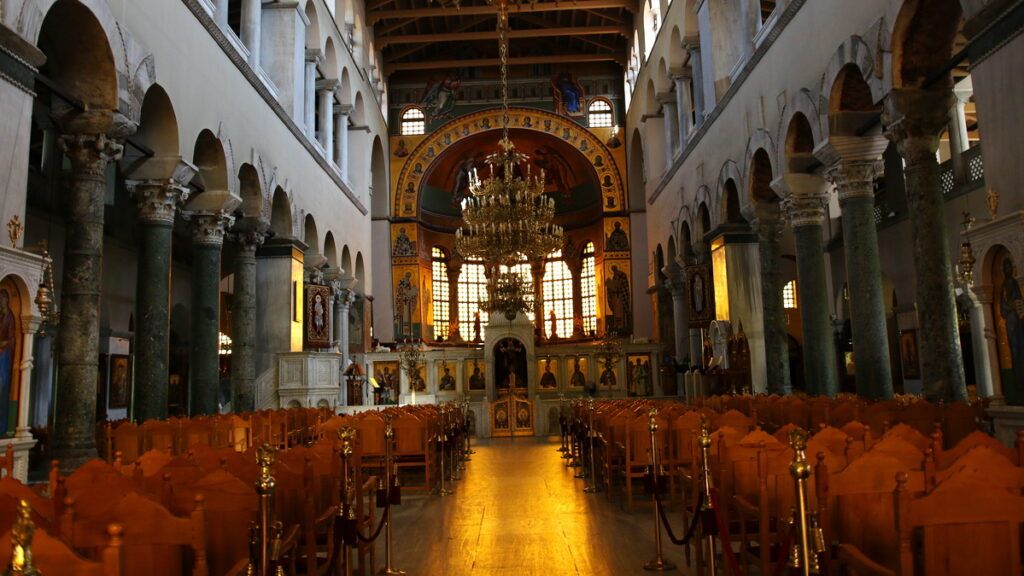
During the 4th century AD, shortly after the martyrdom of St. Demetrios, Thessaloniki was transitioning from being a pagan city into being an early Christian one. Thessaloniki would soon to be one of the most significant cities of the Byzantine Empire. Agios Dimitrios Church is one of many important Byzantine Churches in Thessaloniki.
It was only a few years after the martyrdom of the saint that the first church of Agios Dimitrios was built. The 313 AD Edict of Milan established tolerance of Christianity in the Roman Empire. A small church was built over the bath house where Agios Dimitrios was martyred. A century later, the miracles of the saint were well known. The prefect of Illyricum – Leontius – then built on the site “a most sacred house” – a three-aisled basilica. In the 7th century, it was rebuilt after a fire. Then, in the intervening centuries it became the larger basilica of five aisles that we know today. The south entrance is on Agiou Dimitriou Street, which follows the ancient Roman Decumanus – the main street, connecting the eastern and western gates of the city.
A lot happened in the intervening centuries. And throughout them all, this sacred place continued to be an important spiritual center.
Agios Dimitrios Church throughout the Centuries
Thessaloniki, as you by now know, fell to the Ottoman Empire in 1430. The Ottomans didn’t convert all churches into mosques at once, and some were never converted at all. Agios Dimitrios Church became a mosque in 1493, taking the name Kasimiye. The whole district around the mosque was called the Kasimiye. Kasimiye was none other than the Muslim incarnation of Agios Dimitrios. Throughout the Ottoman years, he was revered by both Muslims and Christians, and Christians were allowed to continue to worship at his tomb. The hodja would even perform rituals for them.
It was a great day for the Christians of Thessaloniki when Agios Dimitrios, after centuries, became a Christian church once again. But their elation was to be short-lived.
Agios Dimitrios Church and the Fire of 1917
In August of 1917, a great fire broke out in Thessaloniki. It would change the shape of city. The fire was moving towards the east, just below the upper town, when it reached Agios Dimitrios. The church burned for hours. Precious Byzantine works were lost. But the vast building did change the fire’s course, directing the fire towards the sea, and away from the Christian neighborhoods where it was head. This was seen by some as yet another intervention by Agios Dimitrios, saving the Christians of Thessaloniki once again.
The Jewish history of Thessaloniki was forever altered though, as much of their quarter of the city was destroyed. The loss included many Synagogues.
Agios Dimitrios stood in charred ruins for decades, its roof and upper walls gone. But it was not all a loss – the fire had revealed some mosaics which had been covered during the Ottoman years. Subsequent excavations also revealed the ruins of the Roman bath house upon which the original church had been built, including what was thought to be the site of the martyrdom of St. Demetrios.
The Reconstruction of Agios Dimitrios Church Thessaloniki
Restoring the church of Thessaloniki’s patron saint was a priority. But in the interwar years, funding the restoration was a challenge. Two postage stamps were issued – one in 1937, featuring a photograph taken in 1913 by the noted Swiss photographer Fred Boissonnas. The other, featuring a mosaic of the saint, was issued in January of 1948.
The initial excavations of Agios Dimitrios were overseen by Aristotelis Zachos, beginning already in September of 1917. It was then that the bath house with its lovely fountain was rediscovered. This area – now the “crypt” – had at one time been above ground. The fountain was associated with the outpouring of myhhr from the middle Byzantine period, around the 10th century. They also discovered the hexagonal marble base of the Ciborium and the mosaics along the southern wall.
Restoration works then began in 1925-1926. In the rebuilding, they used brick masonry so that the reconstructed parts could easily be discerned from the original structure. Works ceased upon the death of Zachos in 1939, to resume only after World War II.
The Restoration of Agios Dimitrios and the Jewish Cemetery of Thessaloniki
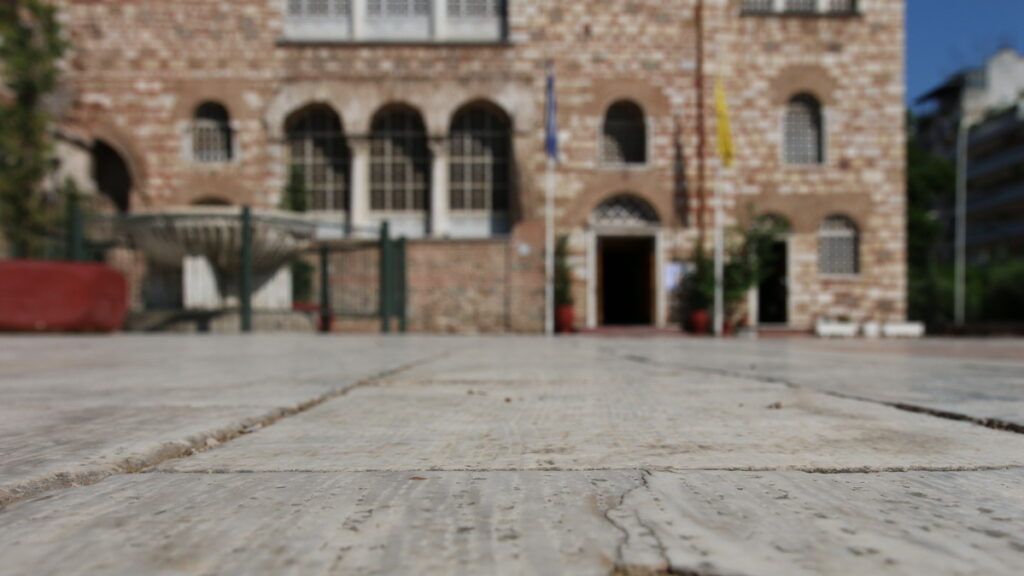
As the church of Agios Dimitrios reflects the many eras and events in the history of the city, it also embodies one of the very saddest.
You’ll recall that the fire of 1917 that destroyed much of the church also destroyed nearly the whole of the Jewish quarter of the city. This included some 30 Synagogues, houses of prayer, schools, and community centers. Much greater loss was to come: Thessaloniki lost over 95% of her Jewish population to the Nazi death camps.
The Jewish cemetery of Thessaloniki was one of the largest in Europe. It was once where the Aristotle University of Thessaloniki is today. During the occupation, the Jewish Cemetery had been destroyed. In addition to gaining a large piece of the city to develop, the city officials also suddenly had lots of building materials – the tombstones of centuries of Jews. These were stripped of the names of the dead, and used in municipal projects all over the city after the war. These tombstones speeded the completion of the square in front of Agios Dimitrios. In 1946, a scholar from Oxford counted stacks and stacks of defaced tombstones outside of Agios Dimitrios.
The Jewish Community appealed to the courts, but to no avail. When we approach the church today, we walk on the tombstones of Thessaloniki’s Jews – a somber truth.
The Reconsecration of Agios Dimitrios Church
On October 26th, 1948, the church of Thessaloniki’s patron saint was finally reconsecrated, even though the restoration was not yet entirely complete. There was a great procession the night before, amid clouds of incense and great throngs of people in the street. King Pavlos and Queen Frederiki were in attendance. The next day, the relics of the saint were brought once again to the church, and a solemn mass was held.
What to See at Agios Dimitrios Church
This basilica of five aisles is filled with precious mosaics and architectural artifacts as well as devotional spaces. The ciborium and shrine are a place of tremendous spiritual power, for both pilgrims and more casual visitors alike.
Saint Demetrios is an important saint for all Orthodox Christians, and the church is a site of pilgrimage. It has longer hours than many other churches, and is often crowded throughout the day.
The Ciborium and Shrine
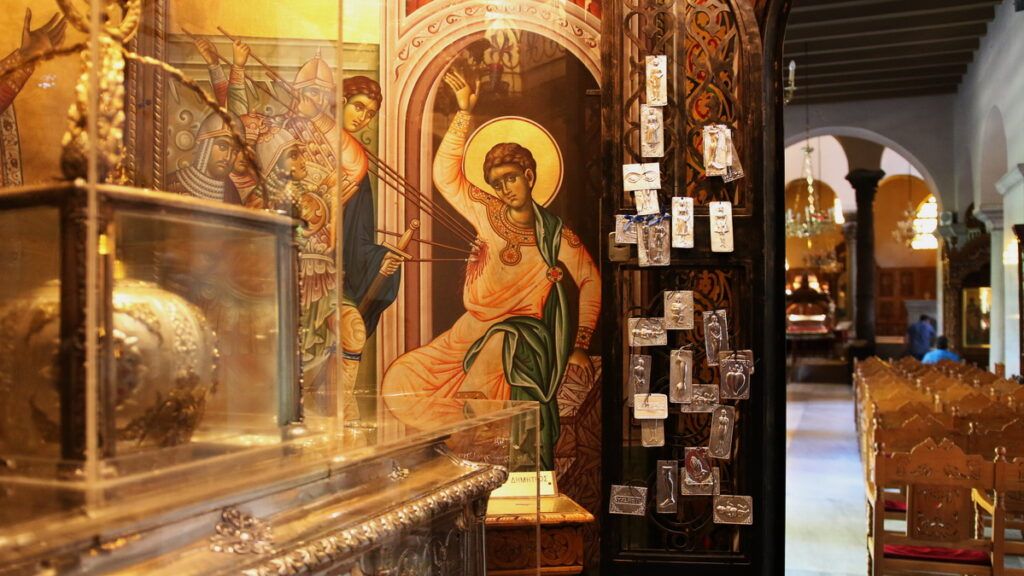
The tomb of the saint was destroyed by the Normans in 1118, and the original Ciborium that contained the holy relics of the saint was destroyed by Saracens in 904. Fascinatingly, devout citizens of Thessaloniki saw in a dream that the relics were under an imprint on the floor of the original hexagonal cevorium. this new marble Ciborium holds a bronze shrine with the relics of Saint Demetrius, a source of blessings and benevolence. This is a destiantion for all pilgrims of the Orthodox faith. Beside the shrine, you’ll see “tama” – votive offerings given in thanks. Beside them is an icon of the saint in martyrdom.
The Mosaics
Many of the original mosaics perished in the fire of 1917. But 9 survive, spanning the 5th through the 9th centuries. Notable among them are children making offerings to the saint, the saint among priests, the saint among patrons and restorers of the church. These are not immediately visible. You can find the mosaics east of the sanctuary, and on the west wall of the nave.
The Variety of Columns
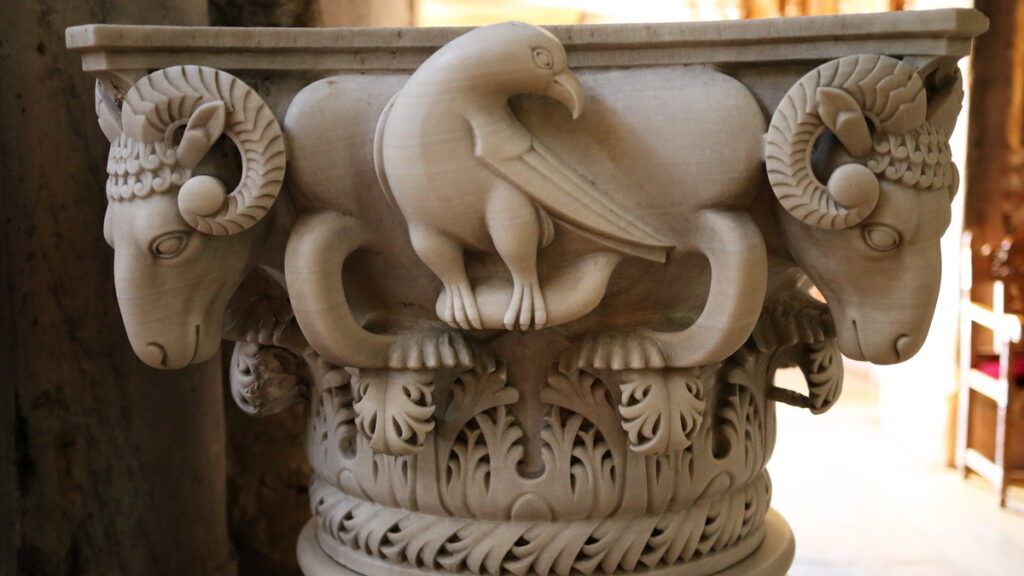
There’s a beautifully organic feel to the central nave of the church. On observation, you’ll see that the columns are not all alike; they’re of varying heights and even of different colors of stone. They have a variety of different capitals. Their bases adjust for the differences in height.
The columns were reclaimed from Roman buildings, Christian buildings, and the previous basilica that was rebuilt in the 7th century. The detail is marvelous; the variety of motifs of the capitals include doves, rams and eagles, intricately abstract botanical motifs, two-zone Theodosian capitals, and acanthus leaves, among others.
The great variety gives the space a dynamic rhythm.
The Tomb of Spandonis
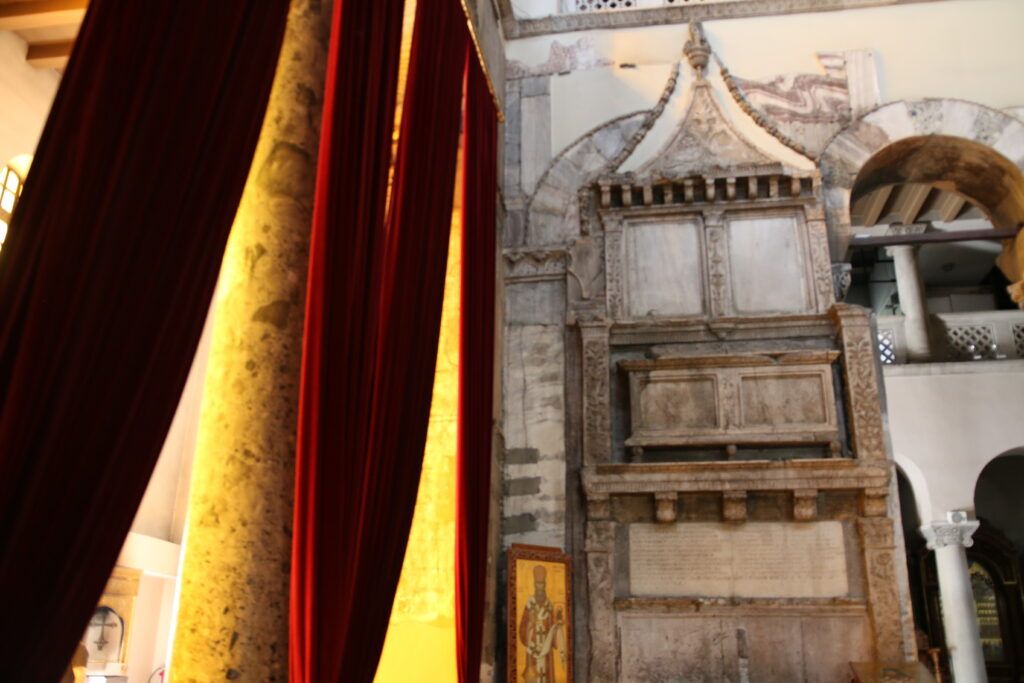
In the west end of the church on the north side of the nave is a distinctive Venetian-style tomb high in the wall. It dates from 1481 – after the fall of Thessaloniki to the Ottomans, but before the church of Agios Dimitrios was converted into a Mosque. This tomb – of the wealthy merchant Loukas Spandonis – is a fine example of Venetian Renaissance art.
The Museum: the Crypt of Agios Dimitrios
The crypt is under the altar, accessed by stairs just to the right of the central nave. It’s actually a museum with findings from the excavations after the fire, and is under the auspices of the ministry of culture rather than the church. A such, it has different hours (below). However, there are services in the crypt each Friday evening – an unusual and meaningful way to experience Agios Dimitrios church.
Agios Dimitrios Church. Agios Dimitrios Street 97 (just above the Roman Forum). Open daily, 6:00 – 22:00. The Crypt is open Mondays – Thursdays, 8:00 – 15:00, and Fridays from 8:00 – 13:00, as well as for mass on Friday evenings.



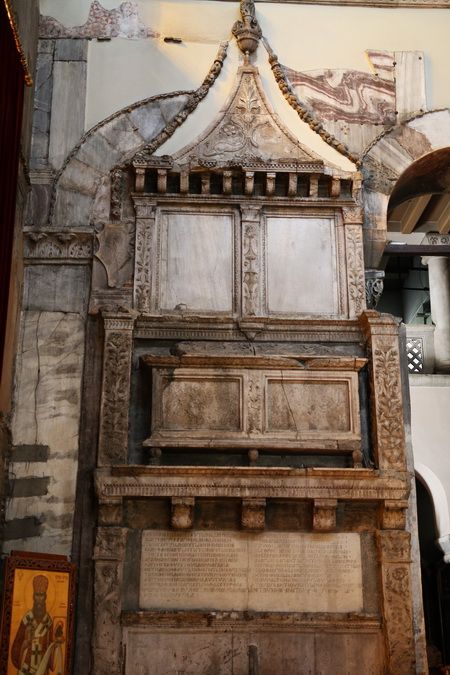
[…] fountain once flowed holy myrrh. Dimitrios is an important Orthodox saint. A center for pilgrimage, Agios Dimitrios church has long opening hours. It’s often crowded, and even […]